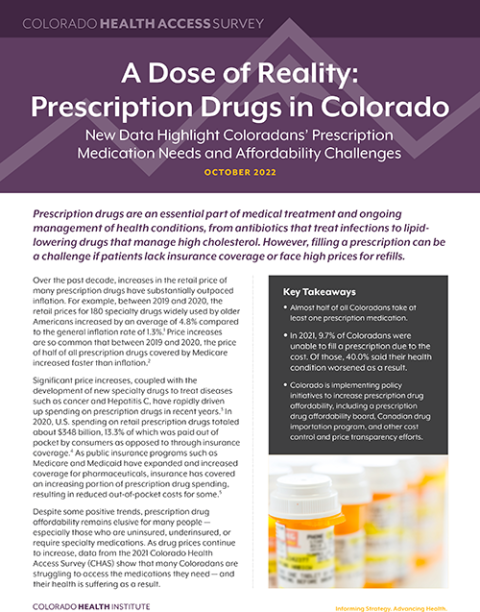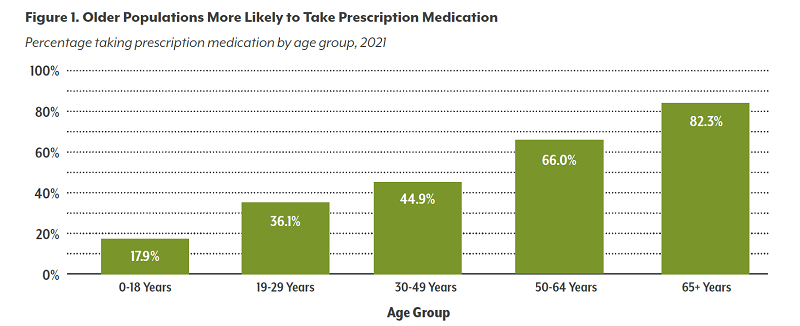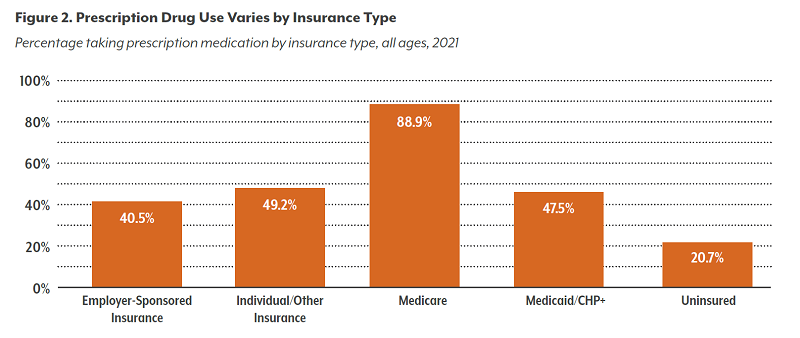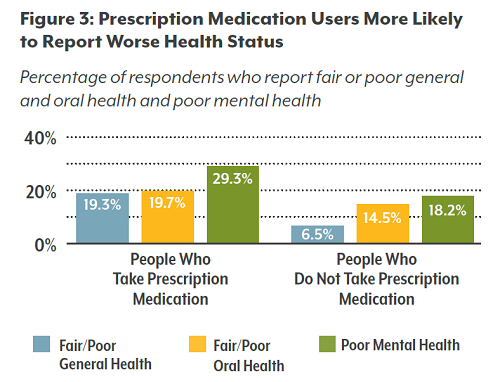Since Medicaid and CHP+ members tend to have low incomes, even the presence of a relatively small copayment may represent a real or perceived barrier. Alternatively, it’s possible that Medicaid and CHP+ members may not be aware of their pharmacy benefits, and the CHAS findings may indicate that building additional awareness of benefits is needed for Medicaid and CHP+ members. CHI hopes to further explore the factors contributing to affordability challenges for prescription drugs and other medical services among Medicaid and CHP+ members in future iterations of the CHAS.
Medicare beneficiaries who take prescriptions have the least trouble affording their medication, with only 5.8% reporting a somewhat or very difficult time affording prescription drugs. This is likely due to a high rate of prescription drug coverage among Medicare beneficiaries: in 2020, 72.7% of Medicare beneficiaries in Colorado had Medicare Part D, also called the Medicare prescription drug benefit.(24)
National data show that Medicare beneficiaries under the age of 65 — those who typically qualify due to disability or end-stage renal disease — are three times more likely to report difficulty affording prescription medication than Medicare beneficiaries over the age of 65. Younger Medicare beneficiaries are more likely to have comorbidities and lower incomes than beneficiaries 65 years and older, likely contributing to the difference in prescription drug affordability between these two Medicare populations.(25)
Going Without: Factors Associated with Skipping a Prescription
With high prescription drug prices and other affordability challenges, many Coloradans are forced to choose between their medications and other expenses, such as food, transportation, or housing. Over 540,000 Coloradans (9.7%) report not filling a prescription due to cost in the past year — more people than live in Colorado Springs. This figure has stayed consistent over the past six years, demonstrating a systemic issue with prescription affordability amid rapidly rising drug prices and other consumer cost pressures. An additional 222,000 Coloradans report not filling a prescription due to some reason other than cost. Although the CHAS does not specifically ask why, other reasons might include inconvenience or fear of medication side effects.
Coloradans don’t feel the burden of paying for prescription medications and other necessities equally. Women are more likely than men to report not filling a prescription due to cost (13.4% compared to 9.2%). This finding is reflective of larger health care affordability trends, as women are more likely than men to incur greater health care costs and to report problems paying medical bills.(26, 27)
Similarly, insurance status plays a large role in the ability of Coloradans to fill their prescriptions. The uninsured were the most likely miss medications, with one in four (25.3%) uninsured Coloradans reporting not filling a prescription due to cost, compared to just 9.6% of Coloradans with any type of insurance.
CHI analyzed four racial/ethnic groups — those who identify as non-Hispanic/Latino white, non-Hispanic/ Latino Black, Hispanic/Latino, and non-Hispanic other race — to see if some groups were more likely to skip filling a prescription due to cost than others. Due to sample size constraints, statistically significant differences are limited. The CHAS data do show that Hispanic/Latino Coloradans are more likely to skip filling a prescription due to cost than non-Hispanic/Latino White Coloradans (12.2% compared to 8.4%). This may be driven in part by the fact that Hispanic/Latino Coloradans consistently experience a higher uninsured rate than other racial/ethnic groups in state, which serves as a barrier to affording medication.(12)
Of those who said they were unable to fill a prescription due to cost, 40.0% indicated that their health condition got worse as a result of forgoing the medication. Skipping prescription medication can have serious health implications. For example, a national study showed that adults with cardiovascular disease who missed filling their medications due to cost experienced higher rates of chest pain, nonfatal heart attacks, and strokes.(28)
Conclusion
Many Coloradans cannot access or afford the prescription drugs they need to be healthy. The scope of the problem for Coloradans — even those with insurance coverage — indicates an urgent need for solutions.
Read the full brief to learn about the legislature's efforts to make prescription drugs more affordable.
Although significant policy and structural barriers remain, Colorado is on the leading edge nationally in taking actions to address these challenges.






